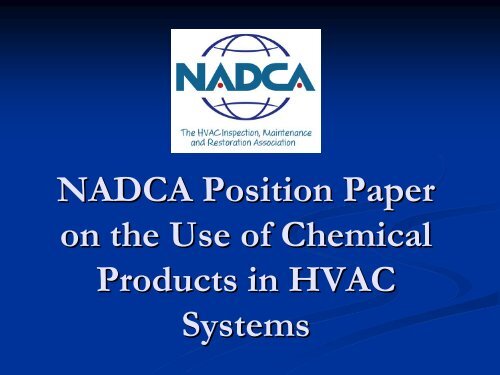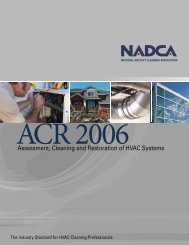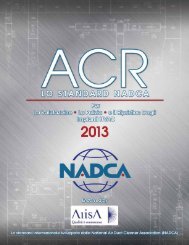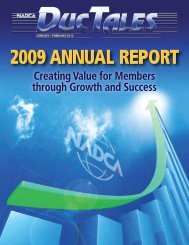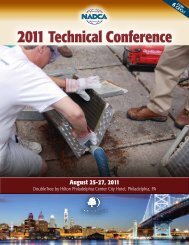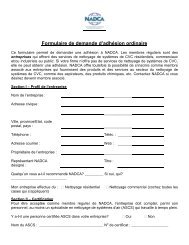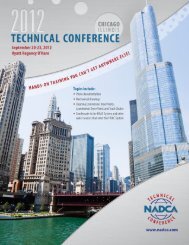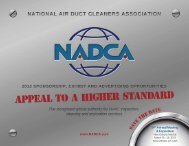NADCA Position Paper on the Use of Chemical Products in HVAC ...
NADCA Position Paper on the Use of Chemical Products in HVAC ...
NADCA Position Paper on the Use of Chemical Products in HVAC ...
You also want an ePaper? Increase the reach of your titles
YUMPU automatically turns print PDFs into web optimized ePapers that Google loves.
<str<strong>on</strong>g>NADCA</str<strong>on</strong>g> <str<strong>on</strong>g>Positi<strong>on</strong></str<strong>on</strong>g> <str<strong>on</strong>g>Paper</str<strong>on</strong>g><strong>on</strong> <strong>the</strong> <strong>Use</strong> <strong>of</strong> <strong>Chemical</strong><strong>Products</strong> <strong>in</strong> <strong>HVAC</strong>Systems
<strong>Chemical</strong> <strong>Products</strong> <str<strong>on</strong>g>Positi<strong>on</strong></str<strong>on</strong>g> <str<strong>on</strong>g>Paper</str<strong>on</strong>g>Task ForceServ<strong>in</strong>g under <strong>the</strong> <str<strong>on</strong>g>NADCA</str<strong>on</strong>g> Educati<strong>on</strong> & SafetyCommittee directed by Mike White
Educati<strong>on</strong> & Safety Committee• Mike White, Chair• Bill Benito• Brian Critch• Doug Groen• Tommy Gwaltney• Matt M<strong>on</strong>giello• Tim O’C<strong>on</strong>norO• Eric Scolari• Alan Sutt<strong>on</strong>• Brad Weaner• Steve Willis
Task Force Members• Dan Greenblatt• Bob Baker• John Bently• Tim Hoysradt• Dan Stradford• Tracy Lantz, EPA• Mike White• Joe MacD<strong>on</strong>ald• Larry Roberts<strong>on</strong>• Dave Governo, , Attorney• Richard Lantz• Cole Stant<strong>on</strong>
PurposeTo provide <strong>the</strong> membership, <strong>the</strong> public,and regulatory agencies with an overview<strong>of</strong> chemical products used <strong>in</strong> and around<strong>HVAC</strong> systems and to provide guidance <strong>in</strong><strong>the</strong> use <strong>of</strong> <strong>the</strong>se materials.
C<strong>on</strong>cerns <strong>of</strong> <str<strong>on</strong>g>NADCA</str<strong>on</strong>g> Members• Which products are authorized for use.• Deal<strong>in</strong>g with safety c<strong>on</strong>siderati<strong>on</strong>s <strong>of</strong> clients andworkers.• Protocols with Material Safety Data Sheets• Avoid<strong>in</strong>g potential legal c<strong>on</strong>fr<strong>on</strong>tati<strong>on</strong>s• Understand<strong>in</strong>g <strong>the</strong> EPA’s s role <strong>in</strong> authoriz<strong>in</strong>g <strong>the</strong>use <strong>of</strong> chemical products
Chem <str<strong>on</strong>g>Paper</str<strong>on</strong>g>• Introducti<strong>on</strong>• Disclaimer• <strong>HVAC</strong> C<strong>on</strong>tam<strong>in</strong>ati<strong>on</strong>• Source Removal• Safety C<strong>on</strong>siderati<strong>on</strong>s & MSDS• Risk Management
Chem <str<strong>on</strong>g>Paper</str<strong>on</strong>g> (c<strong>on</strong>t.)• Categories <strong>of</strong> <strong>Chemical</strong> <strong>Products</strong>• Antimicrobial Pesticides (<strong>in</strong>clud<strong>in</strong>gdis<strong>in</strong>fectants and sanitizers)• Sealants• Resurfac<strong>in</strong>g Materials• Coil Clean<strong>in</strong>g Compounds• Soaps and Detergents• Degreasers• Deodorizers
Info <strong>on</strong> Each <strong>Chemical</strong> Product• Product def<strong>in</strong>iti<strong>on</strong>• Typical <strong>Use</strong>• Applicati<strong>on</strong> Method• Pros and C<strong>on</strong>s <strong>of</strong> <strong>Use</strong>• EPA Requirements• Best Practices
Chem <str<strong>on</strong>g>Paper</str<strong>on</strong>g> (c<strong>on</strong>t.)• Clos<strong>in</strong>g Secti<strong>on</strong>s• Frequently Asked Questi<strong>on</strong>s• References
Introducti<strong>on</strong>One topic that has generated both substantial<strong>in</strong>terest and c<strong>on</strong>cern is <strong>the</strong> use <strong>of</strong> chemicals,cleaners, sealants and coat<strong>in</strong>gs <strong>in</strong>side airhandl<strong>in</strong>g systems. Currently a broad diversity <strong>of</strong><strong>in</strong>formati<strong>on</strong> exists regard<strong>in</strong>g <strong>the</strong> use and efficacy<strong>of</strong> <strong>the</strong>se chemical products. In work<strong>in</strong>g with allparties associated with <strong>in</strong>door air quality,<str<strong>on</strong>g>NADCA</str<strong>on</strong>g> recognizes <strong>the</strong> need to providedirecti<strong>on</strong> <strong>in</strong> this complicated and evolv<strong>in</strong>g area.
Disclaimer<str<strong>on</strong>g>NADCA</str<strong>on</strong>g> recognizes that differences <strong>in</strong> op<strong>in</strong>i<strong>on</strong>will exist as to how to manage <strong>the</strong> use <strong>of</strong>chemical products. <str<strong>on</strong>g>NADCA</str<strong>on</strong>g> also recognizesthat <strong>in</strong>dustry pr<strong>of</strong>essi<strong>on</strong>als will decide whe<strong>the</strong>ror not a chemical applicati<strong>on</strong> is appropriate for agiven <strong>HVAC</strong> system, based <strong>on</strong> <strong>the</strong> uniquecircumstances surround<strong>in</strong>g that system.Ultimately, <strong>the</strong> decisi<strong>on</strong> <strong>of</strong> whe<strong>the</strong>r or not toapply a chemical product <strong>in</strong> an <strong>HVAC</strong> system,and <strong>the</strong> selecti<strong>on</strong> <strong>of</strong> that product, rests with <strong>the</strong>owner <strong>of</strong> <strong>the</strong> system.
Disclaimer (c<strong>on</strong>t.)This document was written <strong>in</strong> <strong>the</strong> United States<strong>of</strong> America and is <strong>in</strong>tended primarily for use <strong>in</strong>this country. This material may also proveuseful for <strong>in</strong>dustry pr<strong>of</strong>essi<strong>on</strong>als and o<strong>the</strong>rsoperat<strong>in</strong>g outside <strong>of</strong> <strong>the</strong> USA. All users <strong>of</strong> thisdocument are encouraged to refer to applicablefederal, state/prov<strong>in</strong>cial, and/or local authoritieshav<strong>in</strong>g jurisdicti<strong>on</strong> over <strong>the</strong> subjects addressedwith<strong>in</strong> this document.
<strong>HVAC</strong> C<strong>on</strong>tam<strong>in</strong>ati<strong>on</strong>Numerous types <strong>of</strong> c<strong>on</strong>tam<strong>in</strong>ati<strong>on</strong> may be foundwith<strong>in</strong> <strong>HVAC</strong> systems. Depend<strong>in</strong>g <strong>on</strong> <strong>the</strong>envir<strong>on</strong>ment and c<strong>on</strong>diti<strong>on</strong>s, <strong>the</strong>se c<strong>on</strong>tam<strong>in</strong>antsmay c<strong>on</strong>tribute to mold/mildew (i.e., fungalgrowth) and o<strong>the</strong>r microbiological growth.O<strong>the</strong>r c<strong>on</strong>tam<strong>in</strong>ants may <strong>in</strong>clude debris fromoutside air sources, fire damage residue, dust,verm<strong>in</strong>, etc.
Source RemovalIt is not necessary to apply chemicalproducts to achieve source removal with<strong>in</strong> an<strong>HVAC</strong> system. However, apply<strong>in</strong>g appropriateclean<strong>in</strong>g compounds may enhance <strong>the</strong> clean<strong>in</strong>gprocess (e.g., coils, hard surfaces, blowers).
Safety C<strong>on</strong>siderati<strong>on</strong>s & MSDSIn <strong>the</strong> United States, <strong>the</strong> Occupati<strong>on</strong>al Safety andHealth Adm<strong>in</strong>istrati<strong>on</strong> (OSHA) requires that <strong>the</strong> MSDSbe available at any job site where chemical products are<strong>in</strong> use. When c<strong>on</strong>centrated products are used at <strong>the</strong>work site, manufacturers may make available a dilutedsoluti<strong>on</strong> MSDS (referred to as a “use soluti<strong>on</strong>”), as wellas sec<strong>on</strong>dary-use labels for <strong>the</strong> applicati<strong>on</strong> c<strong>on</strong>ta<strong>in</strong>er forsuch diluted soluti<strong>on</strong>s. All applicati<strong>on</strong> c<strong>on</strong>ta<strong>in</strong>ers musthave use labels affixed to <strong>the</strong>m.
MSDS (c<strong>on</strong>t.)O<strong>the</strong>r nati<strong>on</strong>s may have different regulati<strong>on</strong>sregard<strong>in</strong>g <strong>the</strong> use <strong>of</strong> <strong>the</strong> MSDS and chemicalproducts so this should be taken <strong>in</strong>toc<strong>on</strong>siderati<strong>on</strong> when deliver<strong>in</strong>g service outside<strong>the</strong> United States.
MSDS (c<strong>on</strong>t.)Some people are sensitive to certa<strong>in</strong>chemical products. If <strong>the</strong>re is a reas<strong>on</strong> to believethat <strong>the</strong> use <strong>of</strong> a product would create a hazard,<strong>in</strong>formati<strong>on</strong> about <strong>the</strong> potential hazard must becommunicated to <strong>the</strong> build<strong>in</strong>g occupants and/ormanagers. In some circumstances, it may benecessary to perform work when occupants areout <strong>of</strong> <strong>the</strong> build<strong>in</strong>g and to adequately ventilate<strong>the</strong> build<strong>in</strong>g. With certa<strong>in</strong> EPA-registeredproducts, build<strong>in</strong>g evacuati<strong>on</strong> is mandatory.
Risk ManagementPossible hazards associated with chemical products<strong>in</strong>clude, but are not limited to:• Allergic reacti<strong>on</strong>s• <strong>Chemical</strong> burns• Respiratory irritati<strong>on</strong> or damage• Eye <strong>in</strong>juries• Pois<strong>on</strong><strong>in</strong>g• Toxic fumes• Exposure to carc<strong>in</strong>ogens
Risk Management (c<strong>on</strong>t.)It is recommended that <strong>the</strong> client sign adocument authoriz<strong>in</strong>g <strong>the</strong> use <strong>of</strong> specificchemical products and acknowledg<strong>in</strong>g that he orshe has been <strong>in</strong>formed <strong>of</strong> risks associated with<strong>the</strong>ir use.
Antimicrobial Pesticides(<strong>in</strong>clud<strong>in</strong>g dis<strong>in</strong>fectants andsanitizers)• Most heavily-reviewed part <strong>of</strong> document.• Must be registered by <strong>the</strong> EPA as well as with<strong>the</strong> state <strong>in</strong> which it will be sold or used.• Def<strong>in</strong>e dis<strong>in</strong>fectant, sanitizer, fungicide, etc.• Def<strong>in</strong>e fungistat, bacteriostat, algaestat• These def<strong>in</strong>iti<strong>on</strong>s are critical <strong>in</strong> determ<strong>in</strong><strong>in</strong>g howa product may be used.
Antimicrobial Pesticides (c<strong>on</strong>t.)• Dis<strong>in</strong>fectant: : An agent that elim<strong>in</strong>ates a specificspecies <strong>of</strong> <strong>in</strong>fectious or o<strong>the</strong>r undesiredmicroorganism, but not necessarily bacterialspores, <strong>in</strong> <strong>the</strong> <strong>in</strong>animate envir<strong>on</strong>ment <strong>on</strong>ly.• Sanitizer: : The term “sanitizer” is <strong>of</strong>ten misusedand misunderstood. A sanitizer is a substanceor mixture <strong>of</strong> substances that kills a highpercentage (99.9%) <strong>of</strong>, but not necessarily all,bacteria <strong>on</strong> a surface.
Antimicrobial Pesticides (c<strong>on</strong>t.)• Fungistat: : An agent that <strong>in</strong>hibits <strong>the</strong> growth<strong>of</strong> fungi <strong>of</strong> ec<strong>on</strong>omic or aes<strong>the</strong>ticsignificance that are not c<strong>on</strong>sidered to behuman health related (<strong>on</strong> envir<strong>on</strong>mentalsurfaces) – similar def<strong>in</strong>iti<strong>on</strong>s forbacteriostat and algaestat.• “-Stat” comes from <strong>the</strong> Greek mean<strong>in</strong>g tostand or keep <strong>the</strong> same.
Antimicrobial Pesticides (c<strong>on</strong>t.)IMPORTANT! Due to <strong>the</strong> complexity <strong>of</strong> EPAregulati<strong>on</strong>s, <strong>the</strong> same product can be registeredas a dis<strong>in</strong>fectant or sanitizer for <strong>on</strong>e use and as abacteriostat, fungistat, , and algaestat for ano<strong>the</strong>ruse. Because <strong>of</strong> this, <strong>the</strong> same product may beused as a sanitizer with<strong>in</strong> an air handler but <strong>on</strong>lyas a bacteriostat and fungistat for ductwork.Thus <strong>on</strong>e can cannot claim to use a “sanitizer”for ductwork because <strong>the</strong> product is notregistered for that use.
Antimicrobial Pesticides (c<strong>on</strong>t.)Example: Ox<strong>in</strong>e is registered with <strong>the</strong> EPA as asanitizer. However, for its use <strong>in</strong> <strong>HVAC</strong>ductwork it is <strong>on</strong>ly registered as a bacteriostatand fungistat.
Antimicrobial Pesticides (c<strong>on</strong>t.)The products which have been accepted by <strong>the</strong> EPA for use<strong>in</strong> <strong>the</strong> ductwork <strong>of</strong> <strong>HVAC</strong> systems <strong>in</strong>clude <strong>the</strong> follow<strong>in</strong>gclaims:• Fungistatic• Bacteriostatic• Inhibits odor-caus<strong>in</strong>g bacteria and fungi• Inhibits sta<strong>in</strong> and damage-caus<strong>in</strong>g bacteria, fungi, and algae• Deodorizes• Inhibits fungi and algae• Clean<strong>in</strong>g (a n<strong>on</strong> pesticidal activity; removal <strong>of</strong>c<strong>on</strong>tam<strong>in</strong>ants)
Sealants• Sealants are materials – liquids <strong>of</strong> vary<strong>in</strong>gviscosity or tapes - used to seal surfaces, jo<strong>in</strong>ts,c<strong>on</strong>necti<strong>on</strong>s, gaps and open<strong>in</strong>gs.• Most sealants do not make claims <strong>of</strong>antimicrobial activity, so do not have to beregistered with <strong>the</strong> EPA.
Resurfac<strong>in</strong>g Materials• Resurfac<strong>in</strong>g materials (also known as repaircoat<strong>in</strong>gs) are coat<strong>in</strong>gs that are applied to surfacesthat show signs <strong>of</strong> damage or degradati<strong>on</strong>.• Some coat<strong>in</strong>gs may c<strong>on</strong>ta<strong>in</strong> antimicrobial<strong>in</strong>gredients to preserve <strong>the</strong> <strong>in</strong>tegrity <strong>of</strong> <strong>the</strong>product, but if <strong>the</strong> product does not makeantimicrobial claims, EPA registrati<strong>on</strong> is notrequired.
Coil CleanersCoil Cleaners are a subset <strong>of</strong> a broadcategory that <strong>in</strong>cludes all hard-surfaceclean<strong>in</strong>g agents. These clean<strong>in</strong>gcompounds differ from general-purposec<strong>on</strong>sumer products <strong>in</strong> that <strong>the</strong> soil thataccumulates <strong>on</strong> surfaces <strong>of</strong> refrigerati<strong>on</strong>and air-c<strong>on</strong>diti<strong>on</strong><strong>in</strong>g coils tends to be moreresistant to removal than soil <strong>on</strong> walls,floors, counter tops and bathroom fixtures.
Coil Cleaners (c<strong>on</strong>t.)In additi<strong>on</strong>, coil structure (especiallyalum<strong>in</strong>um f<strong>in</strong>s) can be more easilydamaged than most envir<strong>on</strong>mentalsurfaces. For example, dried layers <strong>of</strong>organic debris <strong>on</strong> an evaporator coil can bealmost as difficult to remove as baked-<strong>on</strong>oven soil, however, while a th<strong>in</strong> alum<strong>in</strong>umf<strong>in</strong> is easily damaged, <strong>the</strong> porcela<strong>in</strong> orsta<strong>in</strong>less steel surface <strong>of</strong> an oven is highlyresistant to damage.
Coil Cleaners (c<strong>on</strong>t.)• Types: Alkal<strong>in</strong>e, Acid, Detergent• <strong>Use</strong>s for each: Traditi<strong>on</strong>ally, acid cleaners are used <strong>on</strong>c<strong>on</strong>denser coils because <strong>the</strong> types <strong>of</strong> soils that areassociated with <strong>the</strong>ir outside locati<strong>on</strong> are more easilyremoved by <strong>the</strong> acid formulati<strong>on</strong>. In a like manner,alkal<strong>in</strong>e cleaners sometimes work better with <strong>the</strong> greasysoil that is <strong>of</strong>ten found <strong>on</strong> <strong>in</strong>door evaporator, chilledwater, or heat pump coils.• Detailed applicati<strong>on</strong> <strong>in</strong>formati<strong>on</strong>.
Soaps and DetergentsSoaps and detergents are technically known assurfactants, a word that comes from "surface"and "active." Soaps and detergents aresubstances that, when added to water, cause <strong>the</strong>water to dissolve compounds more easily. Theydo so by chang<strong>in</strong>g <strong>the</strong> properties <strong>of</strong> <strong>the</strong> water'ssurface.
DegreasersA chemical product that dissolves fat-based ando<strong>the</strong>r water-<strong>in</strong>soluble substances. Degreasersvary <strong>in</strong> <strong>in</strong>gredients from simple surfactants (seeabove) to powerful caustics that can react witho<strong>the</strong>r chemicals.
DeodorizersDeodorizers remove or mask unwanted odors <strong>in</strong>sidean <strong>HVAC</strong> system or build<strong>in</strong>g. Four types <strong>of</strong>deodorizers are comm<strong>on</strong>:1. Receptor blockers block scent receptors <strong>in</strong> <strong>the</strong> nose fromdetect<strong>in</strong>g certa<strong>in</strong> odors.2. Oxidizers chemically comb<strong>in</strong>e with (oxidize) sources <strong>of</strong>odors <strong>on</strong> surfaces.3. Air sanitizers <strong>in</strong>activate odor-caus<strong>in</strong>g microorganisms.4. Mask<strong>in</strong>g chemicals overwhelm an odor with ano<strong>the</strong>rscent.
Deodorizers (c<strong>on</strong>t.)Any deodorizers that act as pesticides, such assanitizers that <strong>in</strong>activate odor-caus<strong>in</strong>gmicroorganisms, must be registered with <strong>the</strong>EPA.
Frequently Asked Questi<strong>on</strong>s• Should <strong>the</strong> client review <strong>the</strong> MSDS and ProductLabel before authoriz<strong>in</strong>g applicati<strong>on</strong>?• Should occupants leave <strong>the</strong> build<strong>in</strong>g dur<strong>in</strong>gchemical applicati<strong>on</strong>?• How l<strong>on</strong>g should <strong>the</strong> client stay out <strong>of</strong> <strong>the</strong> house orbuild<strong>in</strong>g after chemical applicati<strong>on</strong>?• What if <strong>the</strong> client has asthma, allergies, orchemical sensitivities?• What are <strong>the</strong> advantages to us<strong>in</strong>g <strong>the</strong>se products?
Frequently Asked Questi<strong>on</strong>s• What are <strong>the</strong> risks to us<strong>in</strong>g <strong>the</strong>se products?• Are <strong>the</strong>re any chemical products used <strong>in</strong> <strong>HVAC</strong>systems that can create un<strong>in</strong>tended effects?• Do I need to sanitize my ductwork?• What is <strong>the</strong> positi<strong>on</strong> <strong>of</strong> <strong>the</strong> Nati<strong>on</strong>al Air DuctCleaners Associati<strong>on</strong> (<str<strong>on</strong>g>NADCA</str<strong>on</strong>g>) regard<strong>in</strong>g <strong>the</strong> use<strong>of</strong> chemicals <strong>in</strong> ductwork?• What does <str<strong>on</strong>g>NADCA</str<strong>on</strong>g> recommend for clean<strong>in</strong>gheat<strong>in</strong>g, ventilati<strong>on</strong> and air c<strong>on</strong>diti<strong>on</strong><strong>in</strong>g (<strong>HVAC</strong>)systems?
C<strong>on</strong>clusi<strong>on</strong>It is vitally important that <str<strong>on</strong>g>NADCA</str<strong>on</strong>g>members understand <strong>the</strong> protocols <strong>of</strong> <strong>the</strong>use <strong>of</strong> chemical products <strong>in</strong> <strong>HVAC</strong>systems to avoid customer upsets and legaland regulatory problems and to ensure <strong>the</strong>yare apply<strong>in</strong>g chemical products safely andeffectively.


